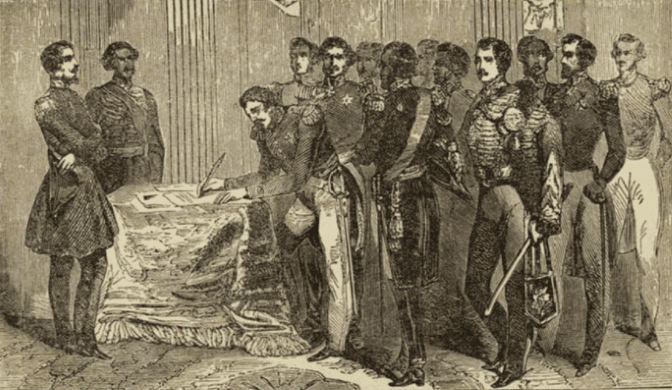The forced cession of Mexican territory to the United States
The Mexican Chamber of Deputies and the U.S. Senate validated the agreement to end the war between the two nations. Peace was achieved and borders were established; Mexico lost half of its territory. February 2 commemorates the 174th anniversary of the Treaty of Guadalupe Hidalgo.

Recognized as an official event, but little remembered for its result that meant the loss of half of Mexico's territory, the Treaty of Guadalupe Hidalgo took place on February 2, 1848, to end the war between Mexico and the United States, which had exhausted our country, says Alfredo Ávila Rueda, a researcher at UNAM's Institute of Historical Research (IIH).
174 years after the event, it was the peace agreement after the war that Mexico faced with the American invasion: first in the northeastern territories of Mexico (then north of Tamaulipas, New Mexico, California, and Nuevo Leon) and then the invasion and blockade of the main Mexican ports, until the irruption of the American army through Veracruz to Mexico City and the departure of the Mexican government from the capital to Queretaro.
The Treaty, ratified on May 30, 1848, established that Mexico would cede half of its territory: all of what are today the states of California, Nevada, Utah, New Mexico, Texas, Colorado, Arizona, and parts of Wyoming, Kansas, and Oklahoma. It was a very costly war, although, in the end, the forced cession of territory was invaluable. The signing was achieved with a divided Mexican government, as some sectors wanted to continue the war to turn it into guerrilla warfare, while others were in favor of pacification.
Apart from achieving peace, it established the borders between Mexico and the United States; it was a boundary treaty that, although it has been modified on numerous occasions, is still in force between the two North American countries.
Texas was not part of this agreement, nor was it included in the war, because it was an independent nation ten years before the war, but it was annexed to the United States and was one of the reasons for the conflict. When the Guadalupe Hidalgo treaty took place, today's federative entities were not yet states of Mexico, but part of the federation's territory, without strict limits.
The agreement marked the Mexican government with divisions. The one who ended up bearing the responsibility was the Congress, the Chamber of Deputies. At that time Mexico was a federal republic (after having been centralist) and managed to promote the signing and recognition of the treaty.
It was ratified by the congresses, the Mexican Congress, which was in Querétaro, and the U.S. Senate. The treaty did not depend so much on the presidency of the Republic. Then Antonio López de Santa Anna, who had been in exile, returned to the country to take charge of the war, together with Valentín Gómez Farías as vice president. By September 15 of that year, without prior notice, Santa Anna withdrew from the capital and resigned from the presidency.
The Congress decided to appoint Manuel de la Peña y Peña as substitute president, but it was for a brief period until Pedro María Anaya took office in Querétaro. The negotiation also established the payment of an amount for indemnification of the lost territory. There were six million dollars, three million were paid immediately and the rest was settled in annual payments, with interest. The United States paid an additional five million dollars to U.S. citizens who had claims against the Mexican government.
Avila Rueda highlights Article 11 of the Treaty, to which little attention is paid. It is shameful for Mexico because based on this precept, the U.S. government was obliged to control the indigenous tribes that crossed the border from one side to the other, pillaged in Mexico, and went to the United States; also to control the bandits.
Mexico renounced exercising its sovereignty on the border, leaving it in the hands of the Americans. As a result, the Americans paid more attention to overpopulated areas such as Texas and paid little attention to sparsely populated New Mexico. The people of northern Mexico could not demand that the Mexican government pursue criminals.
In concluding, Avila Rueda asserts that thereafter, Mexico cooperated to foster the disparity between the two countries, which has grown as the neighboring nation has become a world power.




